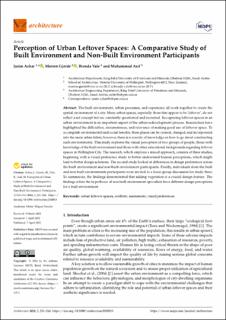| dc.description.abstract | The built environment, urban processes, and experience all work together to create the spatial environment of a city. Many urban spaces, especially those that appear to be ‘leftover’, do not reflect a set concept but are constantly questioned and recreated. Recognizing leftover spaces in an urban environment is an important aspect of the urban redevelopment process. Researchers have highlighted the difficulties, circumstances, and relevance of making good use of leftover space. To accomplish environmental and social benefits, these places can be created, changed, and incorporated into the main urban fabric; however, there is a scarcity of knowledge on how to go about constructing such environments. This study explores the visual perception of two groups of people, those with knowledge of the built environment and those with other educational backgrounds regarding leftover spaces in Wellington City. The research, which employs a mixed approach, consists of three studies, beginning with a visual preference study to better understand human perceptions, which might lead to better design solutions. The second study looked at differences in design preferences across the built environment and non-built environment participants. Finally, individuals from the built and non-built environments participants were invited to a focus group discussion for study three. To summarize, the findings demonstrated that adding vegetation is a crucial design feature. The findings refute the hypotheses of non-built environment specialists have different design perceptions for a built environment. | en_US |

